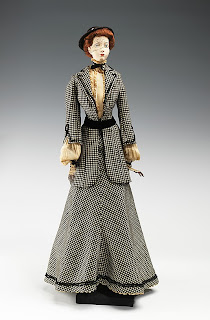While looking for references to riding habits, I came across this little gem. I know what the description sounds like to me, but I'd love to hear your opinions (I feel biased). It's from the Kentish Gazette 28 September 1771.
Dear Madam,
My sister is so impatient for your account of fashionable articles, that she obliged me by this post to give you what she calls the sequel of my last letter. Thus then, in compliance with her orders, I enter upon my description of the dishabille recommended to us by on T----e, a mantua-maker.
The sleeves are close at the wrists, in the nature of your Brunswicks; but, instead of covering the neck, it is fitted to the make of it, and the turn of the shoulder; the back however has no plaits, but is taken in in the same way as a riding habit, and is likewise sloped on the sides, from which and the back it falls elegantly loose, and the slopes, by gradually increasing to the very bottom of the skirt, which is a tolerable length, supplies the whole fullness necessary to make it hang gracefully; it buttons down before with a kind of false stomacher, for the robe itself comes with a loose fold from the top of the sleeve, that forms the front breadths in like manner as the back; the petticoat is of the same and besides its having a very pretty, it has one very singular effect, that it improves the appearance of a fine woman, and conceals every defect in an ill made one: the mantua-maker assures us that it is a recent importation, and that none but a few families, and those of the first distinction, have yet seen it in England.....
Dear Madam,
My sister is so impatient for your account of fashionable articles, that she obliged me by this post to give you what she calls the sequel of my last letter. Thus then, in compliance with her orders, I enter upon my description of the dishabille recommended to us by on T----e, a mantua-maker.
The sleeves are close at the wrists, in the nature of your Brunswicks; but, instead of covering the neck, it is fitted to the make of it, and the turn of the shoulder; the back however has no plaits, but is taken in in the same way as a riding habit, and is likewise sloped on the sides, from which and the back it falls elegantly loose, and the slopes, by gradually increasing to the very bottom of the skirt, which is a tolerable length, supplies the whole fullness necessary to make it hang gracefully; it buttons down before with a kind of false stomacher, for the robe itself comes with a loose fold from the top of the sleeve, that forms the front breadths in like manner as the back; the petticoat is of the same and besides its having a very pretty, it has one very singular effect, that it improves the appearance of a fine woman, and conceals every defect in an ill made one: the mantua-maker assures us that it is a recent importation, and that none but a few families, and those of the first distinction, have yet seen it in England.....

















































